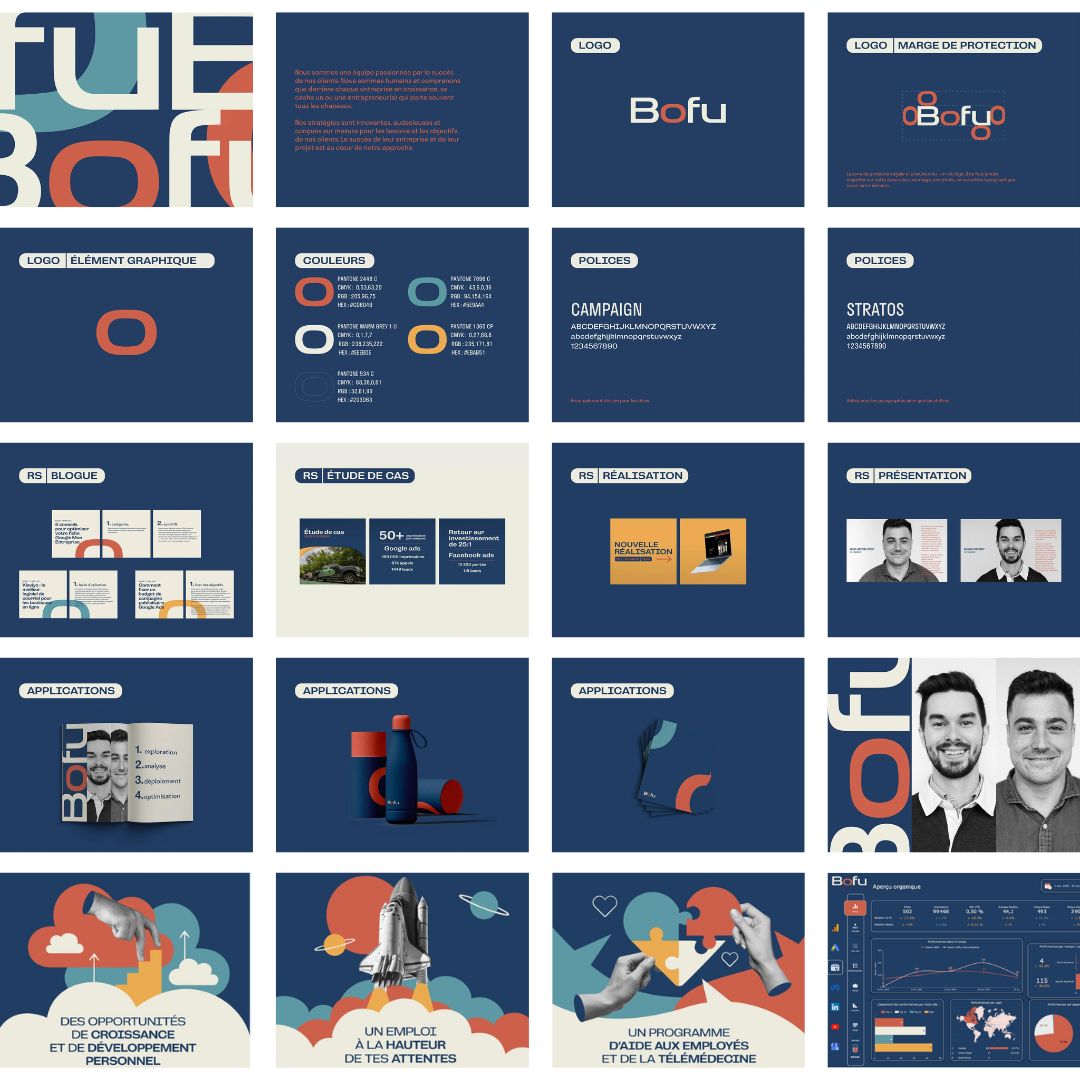When a company decides to review its image and public perception, the development of a new visual identity is often at the heart of this process.
This visual transformation, which includes the creation of a new logo, the choice of distinctive color palettes and adapted typographies, plays a crucial role in redefining the brand and the way it interacts with the world.
In this article, we will explore the key stages of developing a new visual identity, its influence on brand perception and the elements that make this company successful.
Elevate your brand above the competition with our tailored strategies. Explore our rebranding services.
The Creative Process: From Idea to Reality
Developing a new visual identity is a complex strategic process that requires a methodical approach to ensure the transformation is successful. Our visual identity development process is designed to guide our clients through each crucial step of this creative journey. Here's how we do it:
1. ANALYSIS
In this first phase, we dive deep into analysis. Once we have identified your competitors and their positioning, our goal is to determine your differentiator. That is, what sets you apart from the competition in your market. This in-depth analysis will lay the foundation for the transformation to come.
2. DEFINITION
We firmly believe that clearly defining objectives is essential for the success of any project. In this stage, we work closely with you to define your objectives, plan a realistic work plan and help you in its execution. After all, a well-developed plan is only valuable if it is executable in the reality of your business.
3. IMMERSION
Our team immerses itself in your world. We seek to quickly understand the environment and market in which your business operates. This immersion allows us to become true experts in your company and to better understand your needs.
4. VISION
Drawing on our analytical expertise, we work with you to develop and execute an optimized marketing strategy. Our goal is to create a strategy that you can easily operate and execute subsequently, thus ensuring the sustainability of your visual identity.
5. POSITIONING & COMMUNICATION
Through workshops and in-depth discussions, we articulate brand positioning and define the multiple elements needed for your business. This step is crucial to ensure that your new visual identity is in line with your vision.
6. BRAND STRATEGY
We deliver a comprehensive brand strategy , including a comprehensive analysis. In addition, we help you integrate this strategy into your organization. Our analysis will give you an in-depth understanding of your business and your market. We also provide a comprehensive digital strategy, which can be combined with traditional marketing.
7. CREATION OF LOGOS AND BRANDING
Creating a memorable logo is essential, but our approach goes beyond that. We create brands that will stay relevant and evolve with your business. While branding is about more than just designing a logo, we recognize the crucial role of a logo and what it communicates.
8. BOLD VISUAL IDENTITY
By adapting and testing brand building blocks, we create bold visual identities that represent you and are aligned with your overall strategy.
9. MANIFESTO AND BRAND GUIDE
Your brand manifesto is a powerful statement of intent that underpins everything your business stands for. We ensure that it is conveyed both internally and externally to your organization. Your manifesto should shine through in everything you do or sell, reinforcing your visual identity and brand reach.
By following this methodical process, we are able to create impactful visual identities that stand the test of time and contribute to the success of our clients.
The Role of the Logo
The Deep Meaning of the Logo
The logo is much more than just an image; it's the face of your business, the first thing people notice and remember. It must be memorable, capable of arousing emotions and conveying the very essence of the brand at a glance. To achieve this, creating a successful logo requires careful thought.
Logo Colors
Choosing colors is one of the most crucial aspects of creating a logo. Each color evokes specific emotions and associations. For example, blue is often associated with confidence, reliability and serenity, while red can evoke passion, energy and urgency. The choice of color palette must be in harmony with the identity of the brand and the values it wishes to convey.
Shapes and Symbols
Besides the colors, the shapes and symbols used in the logo also have great importance. Geometric shapes, soft curves, abstract symbols or concrete representations, all help to define the character of the logo. For example, a technology company might opt for a logo with clean, modern lines , while a craft business might favor organic, artisanal elements.
Logo Adaptability
A logo must adapt harmoniously to all of the company's communication media, whether it is the website, printed media, products or signs. It must be as effective in black and white as in color, and it must remain recognizable, even at a small size. Simplicity is often the key to this adaptability, as overly complex logos can lose their impact when scaled down.
4. Color Palette
Emotions and Color Associations
Choosing an appropriate color palette is a crucial step in creating visual identity. Colors are not just aesthetic, they evoke specific emotions and associations. For example, green is often associated with nature, freshness and growth, while purple can evoke creativity, royalty and mystery. It is essential that the colors chosen reflect the identity of the brand and the messages it wishes to convey.
The Harmony of the Palette
A well-chosen color palette reinforces brand consistency across all media. Colors should not only be in harmony with each other, but also with the entire visual identity. This includes the logo, typography, graphics and even photographs used. Visual harmony creates a cohesive experience for customers and builds brand recognition.
5. Typography and Fonts
The Impact of Typography
Typography, often underestimated, plays a subtle but powerful role in visual identity. The choice of font can affect the readability, credibility and uniqueness of the brand. Each font has its own personality, whether it's the seriousness of a traditional serif font, the modernism of a sans serif font, or the originality of a script font. The typography must be consistent with the personality of the brand.
Coherence of Typography
Once the typography has been chosen, it is essential to maintain consistency in its use. This means setting clear rules about which fonts are used in which context. For example, one font may be reserved for headings, while another is used for running text. This consistency builds brand recognition and creates a unified visual experience for customers.
In conclusion, the role of the logo, the choice of color palette and typography are essential elements of a brand 's visual identity. Each of these elements helps define the brand personality, evoke emotions in customers and reinforce visual coherence. Careful consideration and understanding of brand values is required to make informed decisions in these areas.
Omnichannel Adaptation: Consistency across All Channels
In a world where communication spans multiple channels, it is essential that the visual identity is adaptable and consistent across all of these channels. Whether on social networks, mobile applications, printed media or online advertising , omnichannel guarantees a harmonious customer experience. Our approach is based on the principles of omnichannel to ensure that your visual identity remains consistent, regardless of the point of contact with your audience. Here's how we do it:
Multichannel Adaptability
We design your visual identity keeping flexibility in mind. This means that every element of your visual identity, from the logo to the typography, is designed to fit naturally across a variety of channels. So whether on social media, mobile devices or print media, your brand remains recognizable and consistent.
Omnichannel Integration
Omnichannel integration is at the heart of our process. We ensure all your brand visual elements are seamlessly integrated across all channels. This means that your website, mobile app, social media profiles, and even online ads have a uniform appearance, boosting your brand's memorability.
Communication Consistency
Omnichannel is not just about the visual appearance, but also the message you communicate. We ensure that communication on all channels is consistent with your visual identity. From the brand voice to the values you embody, everything is aligned to create a smooth and harmonious customer experience.
7. The Impact on Brand Perception
A new visual identity can have a significant impact on how the brand is perceived. Customers often associate a company's appearance with its credibility, modernity and relevance. A successful visual redesign can revitalize brand perception and attract new audiences.
Renewal of Credibility
An updated visual identity can strengthen the credibility of your business. Customers tend to trust brands that show they are evolving with the times. A new visual identity demonstrates your commitment to innovation and quality.
Image Modernization
Modernizing the image is a key element of the visual overhaul . A fresh, contemporary appearance can attract the attention of a new generation of customers. This shows that your business is in tune with current trends.
Renewed Relevance
A redesigned visual identity can make your brand feel more relevant than ever. This can help you stand out from the competition and attract customers who are looking for innovative and current solutions.
Ultimately, a redesigned visual identity can be a game-changer for your business. It can revitalize your credibility, modernize your image and strengthen your relevance in the market. This shows that your business is ready to scale and thrive in an ever-changing environment.
Case Studies: Bringing Transformation to Reality
To better understand the concrete effect of a new visual identity, let's look at some case studies. These examples will illustrate how a visual redesign can positively influence a business.
Airbnb: Openness and Accessibility
When Airbnb redesigned its logo and website in 2014, their goal was clear: to embody openness and accessibility. The result was the creation of a simple and welcoming logo, as well as a user-friendly website reflecting these core values. This overhaul helped strengthen Airbnb's position in the home rental market. The company has become synonymous with friendliness and accessible travel, thereby attracting new users and strengthening the loyalty of existing customers.
Slack: Simplicity and Consistency
In 2019, Slack, the business communications platform, unveiled a new visual identity. They moved from a multi-colored logo to a simpler color palette and consistent typography. This visual overhaul aimed to reflect the simplicity and efficiency of the platform. The impact has been significant, reinforcing the perception of Slack as a modern and intuitive work tool.
Expert Advice: Rebranding Know-How
In the field of graphic design and rebranding, expert advice is invaluable. Here are some essential tips from seasoned professionals:
Stay True to the Brand Essence
When rethinking your visual identity, don't lose sight of the essence of your brand. Changes should evolve naturally from what makes your business strong. Consistency is key to maintaining brand recognition.
Simplicity is Often the Key
Don’t give in to the temptation of complexity. Logos and simple visual elements are more memorable and easier to recognize. The goal is to create a visual identity that communicates instantly and effectively.
Test With Your Target Audience
Before finalizing your visual identity, test it with your target audience. Feedback from those who will have direct contact with your brand is invaluable. This will allow you to make adjustments based on concrete feedback.
Measuring Success: Transformation Indicators
Ultimately, the success of a new visual identity can be measured through various metrics. Here are some of the signs of success to look out for:
Increase in Brand Awareness
A strong visual identity can help increase awareness of your brand. People will more easily recognize your business and associate the brand's appearance with its identity.
15 KPIs to watch:
-
Brand awareness :
- Number of brand mentions on social media
- Recognition rate of the new visual identity among the target audience
-
Online Engagement:
- Engagement rate on social posts (likes, shares, comments)
- Evolution of the number of subscribers on social media
-
Web traffic:
- Increased traffic to the company website
- Website bounce rate (to assess retention)
-
Conversions:
- Website conversion rate (sales, contact forms, registrations)
- Evolution of online sales or leads generated
-
Brand Perception:
- Customer surveys to measure their perception of the brand before and after the visual redesign
- Response rates to customer satisfaction surveys
-
Reputation :
- Evolution of online ratings and reviews (e.g.: Google Reviews, Yelp)
- Number of positive reviews compared to negative reviews
-
Return on Investment (ROI):
- Comparison of turnover before and after the visual overhaul
- Calculation of ROI taking into account rebranding expenses
-
Market share :
- Evolution of market share compared to the competition
- Ranking of the company compared to its competitors on search engines
-
Employee Engagement:
- Employee engagement surveys to assess internal perception of the new visual identity
- Employee reactions on corporate social media
-
Communication Indicators:
- Open rates and click-through rates for email marketing campaigns
- Number of impressions and clicks on online advertisements
-
Local Notoriety:
- Evolution of brand awareness at local level (if relevant)
- Number of in-store visitors (if applicable)
-
Adequacy with the Initial Objectives:
- Evaluation of the achievement of the objectives defined at the start of the rebranding project
- Comparison of results to initial expectations
-
Website Loading Time:
- Measuring website loading speed, as this can affect user experience
-
Cost per Acquisition (CPA):
- Cost of acquiring a new customer or lead thanks to the new visual identity
-
Customer Returns and Internal Returns:
- Collection of feedback and suggestions from customers and employees on the new visual identity
Sales Growth
A successful visual transformation can have a positive impact on sales. Customers are attracted to a brand that seems modern, credible and relevant. This can result in increased sales.
Positive Customer Reaction
Carefully monitor your customers' reaction to the new visual identity. Positive comments, mentions on social networks and testimonials are all signs that the transformation is well received.
In summary, a new visual identity can change the dynamics of your business. By following expert advice and measuring success metrics, you can create a visual transformation that strengthens your market position and attracts new audiences.
Conclusion
In conclusion, the development of a new visual identity is a strategic approach that goes well beyond aesthetics. It is a creative journey that begins with in-depth research and results in a meaningful visual transformation. The logo, color palette and typography are key elements that need to be carefully thought through. A well-designed visual identity strengthens the brand, influences perception and can lead to success. Case studies show how companies revitalized their image through successful rebranding, and expert advice highlights the importance of simplicity and brand loyalty. Finally, measuring success through various KPIs makes it possible to assess the concrete impact of this visual transformation on the company.
FAQ (Frequently Asked Questions)
1. What is a visual identity? A company's visual identity encompasses all the visual elements that represent it, such as the logo, colors and typography.
2. Why is visual rebranding important? It is essential because it reflects the evolution of the company, attracts new audiences and strengthens the perception of the brand.
3. How to choose the right colors for a visual identity? Colors should match the brand identity and evoke the appropriate emotions. Thorough research is needed.
4. What is the role of the logo in the visual identity? The logo is the emblem of the brand, it must be memorable and convey the essence of the company.
5. How to measure the success of a new visual identity? KPIs such as brand awareness, conversions, and reputation can be used to gauge success.
6. How long does it take to create a new visual identity? The duration depends on the complexity of the project, but it can take several weeks to several months.
7. Should design experts be involved? Yes, design and rebranding experts can provide valuable perspective and ensure a quality result.
8. What are the benefits of a consistent visual identity across multiple channels? Omnichannel guarantees a harmonious customer experience across all communication channels.















